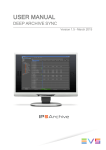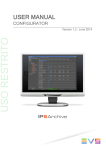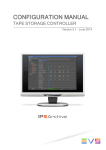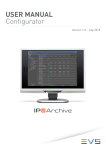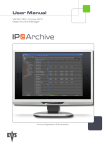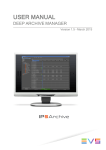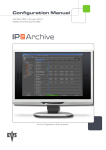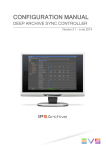Download File Transfer Daemon configuration manual 3.7
Transcript
CONFIGURATION MANUAL FILE TRANSFER DAEMON Version 3.7 - June 2014 CONFIGURATION MANUAL IP2Archive 1.4 File Transfer Daemon 3.7 Copyright EVS Broadcast Equipment SA– Copyright © 2003-2014. All rights reserved. Disclaimer The information in this manual is furnished for informational use only and subject to change without notice. While every effort has been made to ensure that the information contained in this user manual is accurate, up-to-date and reliable, EVS Broadcast Equipment cannot be held responsible for inaccuracies or errors that may appear in this publication. Improvement Requests Your comments will help us improve the quality of the user documentation. Do not hesitate to send improvement requests, or report any error or inaccuracy on this user manual by e-mail to [email protected]. Regional Contacts The address and phone number of the EVS headquarters are usually mentioned in the Help > About menu in the user interface. You will find the full list of addresses and phone numbers of local offices either at the end of this user manual (for manuals on hardware products) or at the following page on the EVS website: http://www.evs.com/contacts. User Manuals on EVS Website The latest version of the user manual, if any, and other user manuals on EVS products can be found on the EVS download center, on the following webpage: http://www.evs.com/downloadcenter. I CONFIGURATION MANUAL IP2Archive 1.4 File Transfer Daemon 3.7 Table of Contents Table of Contents TABLE OF CONTENTS I WHAT'S NEW II 1. 1 ABOUT THE APPLICATION 1.1. After Installation 2 1.2. After Configuration 2 1.3. Version and License Check 3 1.4. Main Window Overview 5 2. 8 MONITORING FILE TRANSFERS 2.1. File Transfer Data 8 2.2. File Transfer Status 9 2.3. Retrying File Transfer Errors 9 2.4. Hiding and Unhiding Columns 10 2.5. Reordering Columns 11 2.6. Settings Window 12 2.6.1. Overview User Settings Subcategories 14 2.6.2. MAD Tab 14 2.6.3. Overview System Settings Subcategories 15 2.6.4. Logging Tab 15 2.6.5. MAD Options Tab 16 2.6.6. Oracle Connection Tab 17 2.6.7. E-Mail Options Tab 19 2.6.8. FTP Tab 20 I EVS Broadcast Equipment SA Issue 3.7.D - June 2014 What's New In the Configuration Manual of the File Transfer Daemon the icon has been added on the left margin to highlight information on new and updated features. The changes linked to new features in version 3.7 are listed below. The version of the application and the validity of the license are checked at startup. • See section "Version and License Check" on page "3". The splash screen now also displays the database name and version and the date until which the license is valid. See section "Main Window Overview" on page "5" The columns in the main window grid can now be re-arranged, hidden and made visible again. • See section "Reordering Columns" on page "11". • See section "Hiding and Unhiding Columns" on page "10". The settings have been rearranged and certain settings can only be configured in the Configurator. II What's New CONFIGURATION MANUAL IP2Archive 1.4 File Transfer Daemon 3.7 1. About the Application General Description File Transfer Daemon is an automated application that transfers the files to be archived (video files, metadata XMLs, etc.) from the IPDirector nearline storage to the XenData Cache where it will be picked up by the XenData archiving workflow. For restores it will check when the restoring from LTO to the Cache is finished and then transport the file back to the IPDirector nearline storage. Workflow The diagram below shows the interactions between IPDirector and the various IP2Archive software components, and between the various IP2Archive software components and the HSM system. When IP2Archive interfaces with SGL's FlashNet, Front Porch Digital's DIVArchive or Atempo's Digital Archive, File Transfer Daemon is replaced by Tape Storage Controller. 1. About the Application 1 EVS Broadcast Equipment SA 1.1. Issue 3.7.D - June 2014 After Installation Double-click the File Transfer Daemon icon on the desktop of the application server to start the application. You can also start the application by double-clicking the executable file (.exe) in the installation folder. The splash screen appears. The application logs into the database. Then, the Settings window appears allowing you to configure the application. See section "Settings Window" on page "12". 1.2. After Configuration Double-click the File Transfer Daemon icon on the desktop of the application server to start the application. You can also start the application by double-clicking the executable file (.exe) in the installation folder. The splash screen appears. The application logs into the database. Then, the main window opens. Depending on the settings, the application will either automatically start executing file transfers after a certain time interval, or you will have to click the Start button first. 2 1. About the Application CONFIGURATION MANUAL IP2Archive 1.4 File Transfer Daemon 3.7 1.3. Version and License Check Introduction The version of the application and the validity of the application license will be checked when the application logs into the IP2Archive database at startup. The status of the version or the license that is returned is displayed on the application splash screen. Version and License Statuses The following version and license statuses can be returned: Status Description Color Action Required Current The actual version of the application. no color No action required. The application starts automatically. Outdated A newer version of the application exists, but this version can still be used. red By default, the application starts automatically after 10 seconds. The application version that should be installed is displayed. Obsolete A newer version of the application exists and must be used. This version may not be used anymore. Click OK to start the application at once. red Click OK to continue. The application shuts down. The application version that should be installed is displayed. Undefined The version of the application is not defined in the MAD database. black Click OK to continue. The application shuts down. 1. About the Application 3 EVS Broadcast Equipment SA Issue 3.7.D - June 2014 Status Description Color Action Required Beta A test version. blue Click OK to start the application. By default, the application starts automatically after 10 seconds. License About to Expire The license period is about to expire. It is shown in how many days the license will expire. orange By default, the application starts automatically after 10 seconds. Contact your system administrator or check the License Controller manual. License Expired The license period has expired. The date when the license expired is displayed. Click OK to start the application at once. red Click OK to continue. The application shuts down. Contact your system administrator or check the License Controller manual. No Valid License There was no valid license found in the database. red The application shuts down. Contact your system administrator or check the License Controller manual. Maximum Licenses Reached The maximum number of instances <NUMBER OF LICENSES> for the license has been reached. Click OK to continue. red Click OK to continue. The application shuts down. Contact your system administrator or check the License Controller manual. 4 1. About the Application CONFIGURATION MANUAL IP2Archive 1.4 File Transfer Daemon 3.7 1.4. Main Window Overview General Description The main window displays the file transfers that are being or have already been performed. It allows you to monitor the file transfer status and progress, check for possible errors and retry failed transfers. Illustration The main window contains the areas highlighted on the screenshot below: Area Description The table below describes the various parts of the main window: Part 1. 1. About the Application Name Description Title bar The Title bar displays the name of the application and the software version number. Between square brackets the instance of the application that was selected in the settings appears. If no instance has been selected yet, [Undefined] appears. 5 EVS Broadcast Equipment SA Part Issue 3.7.D - June 2014 Name Description 2. Menu bar The Menu bar contains three menus: File, Settings and Help. 3. Start/Stop buttons The Start/Stop buttons are used to manually start and stop the application. 4. Status field The Status field displays the current status of the application. 5. Transfers pane The Transfers pane gives an overview of the file transfers that are being or have been executed by the application. The status of each file transfer is displayed. 6. Log pane The Log pane lists application events and can be useful when you are trying to verify that automations are working correctly. The date and time of each event is displayed. By default, this pane is hidden. To display it, click the splitter bar. Menu Bar The menu bar contains three menus: File, Settings and Help. File Menu The File menu contains only one command: Exit. It is used to exit the application. Click the File menu or use the keyboard shortcut keys ALT + F or F10 + F to open it. Click Exit or use the keyboard shortcut key X to exit the application. Settings Menu The Settings menu does not contain any commands. It immediately gives access to the application settings. Click the Settings menu or use the keyboard shortcut keys ALT + S or F10 + S to access the settings. Help Menu The Help menu contains only one command: About. Click the Help menu or use the keyboard shortcut keys ALT + H or F10 + H to open it. With the About command the application about box can be opened. The about box displays the application software version, the date until which the application license is valid, the name and version of the database the application is logged on to and the login name used. Click About or use the keyboard shortcut key A to open the about box. Note These menus only become available after you have clicked the Stop button. 6 1. About the Application CONFIGURATION MANUAL IP2Archive 1.4 File Transfer Daemon 3.7 Status Field The Status field displays the current status of the application. In Automatic Mode, the Status field will display the status AUTO at start-up, indicating that the application will automatically start processing file transfer requests and executing file transfers. After a certain time interval specified in the settings, the status will automatically turn into Active. In Manual Mode, the Status field will display the status INACTIVEat startup. If you then click the Start button, the status will immediately turn into ACTIVE. Warning File Transfer Daemon cannot be exited while performing transfers. You will have to click the Stop button first before you can exit File Transfer Daemon. 1. About the Application 7 EVS Broadcast Equipment SA Issue 3.7.D - June 2014 2. Monitoring File Transfers 2.1. File Transfer Data The File Transfer pane displays the information about the file transfer jobs that have been or that are being executed. The table below describes the information that is displayed: 8 Data Description Application Name of the File Transfer Daemon instance that is performing the file transfer. This field is empty if the instance is undefined. Created Time and date the file transfer job was requested. Error Brief description of the error that occurred. This field is empty if there are no errors. Filename Name of the file to be transferred. Filesize Size of the file to be transferred. This field is empty is the filesize is 0. ID Unique identifier of the file transfer job. Nb. Err. Number of times File Transfer Daemon transferred the requested file unsuccessfully. This field is empty if the number of errors is 0. Progress Progress bar displaying the progress of the file transfer. This field is empty if the file transfer has not started yet. Source Name of the source folder volume. Started Date and time the file transfer started. This field is empty if the file transfer has not started yet. Status Status of the file transfer job. Target Name of the target folder volume. Time Duration of the file transfer. This field is empty if the file transfer has not started yet. Title Name of the file transfer job. Type Type of transfer method used. 2. Monitoring File Transfers CONFIGURATION MANUAL IP2Archive 1.4 File Transfer Daemon 3.7 2.2. File Transfer Status Each file transfer can have one of the following statuses: 2.3. Status Color Description Abort Req. orange A request has been made to abort the file transfer. Aborted olive The file transfer has been aborted. Error red An error occurred during the file transfer. Executed lime The file transfer has been executed successfully. Failed purple The file transfer has reached its maximum number of retries, i.e. went in error the maximum number of times. Other Appl blue The file transfer request has been assigned to another File Transfer Daemon instance. Processing yellow The file transfer is being executed. Requested white The file transfer has been requested and assigned to this File Transfer Daemon instance. Undefined gray The file transfer request has not yet been assigned to a particular File Transfer Daemon instance. Retrying File Transfer Errors Sometimes, an error can occur during a file transfer. The file transfer job will go into error. A Retry button and a detailed error description will appear. 2. Monitoring File Transfers 9 EVS Broadcast Equipment SA Issue 3.7.D - June 2014 If you click the Retry button, File Transfer Daemon will retry a number of times to perform the file transfer job. The number of retries has been configured in the database and depends on the type of error. The error code will be reset to 0 and the status will be set to Requested again. As long as the file transfer job has not failed, you can retry it. Once the file transfer job has failed, the Retry button will no longer be available. 2.4. Hiding and Unhiding Columns You can temporarily hide columns from a grid without having to remove them. Afterwards, you can easily make them visible again. How to Hide a Column To hide a particular column from a grid, proceed as follows: 1. Click the Show/Hide/Move button in the top left corner of the grid. A drop-down list will appear with the available columns. 2. Deselect the check box next to the header of the column you want to hide from the grid. How to Unhide a Column To make a hidden column visible again, proceed as follows: 1. Click the Show/Hide/Move button in the top left corner of the grid. A drop-down list will appear with the available columns. 2. Select the check box next to the header of the column you want to make visible again. 10 2. Monitoring File Transfers CONFIGURATION MANUAL IP2Archive 1.4 File Transfer Daemon 3.7 2.5. Reordering Columns If you want the information in a grid to be displayed in a different order, you can change the position of the columns. There are two ways to reorder columns. Using a Drag-And-Drop Action To reorder a column by directly dragging its header, proceed as follows: 1. Click the header of the column you want to move and hold down your left mouse button. 2. Drag the column header to the desired position in the grid. Two arrows will indicate where it is possible to insert the column. A black prohibition sign will indicate where the column cannot be inserted. 3. Release the left mouse button to insert the column. Using the Show/Hide/Move Button You can also reorder the columns of a grid by using the Show/Hide/Move button: 1. Click on the left side of the first column header. A drop-down list containing the headers of the grid columns appears. The column headers are listed in the order in which the columns are displayed in the grid. The first header in the list is the leftmost field in the grid. The columns that are visible in the grid are selected. The headers in the screenshot below can differ from the headers available in your application. 2. Select a header and drag it to the desired position in the list. Green arrows will appear indicating where you can insert the grid. 2. Monitoring File Transfers 11 EVS Broadcast Equipment SA 2.6. Issue 3.7.D - June 2014 Settings Window Opening the Settings Window The Settings window allows you to configure your application. The first time the application is launched after it has been installed, the Settings window opens automatically. To make this menu available, click the Stop button. The application will stop performing its tasks. Overview Setup Categories The settings can be divided into two setup categories. In the Settings window, a tab is provided for each setup category. The table below briefly describes each setup category: 12 2. Monitoring File Transfers CONFIGURATION MANUAL IP2Archive 1.4 File Transfer Daemon 3.7 Setup Category Description User Settings These settings can be configured by each individual user. System Settings These settings configure the general functioning of the application. They can only be configured by the system administrator. 2. Monitoring File Transfers 13 EVS Broadcast Equipment SA Issue 3.7.D - June 2014 Edit Mode To be able to edit the System settings, you first have to enter a password. To put the Settings window into Edit Mode, proceed as follows: 1. Click the Enter Into Edit Mode button . A dialog box appears. 2. Enter the administrator password and then click OK. The Settings window enters into Edit Mode. Note Certain settings are read-only and cannot be configured. These can only be modified in the Configurator application. Other settings have to be configured locally. 2.6.1. Overview User Settings Subcategories The System settings are divided into the following subcategories: • 2.6.2. MAD MAD Tab The MAD tab allows you to configure how the name of the source and target location will be displayed in the main window of File Transfer Daemon. If you select the radio button: • 14 Volume, the name of the source, i.e. the storage area containing the file that has to be transferred, will only contain the source storage volume name. The name of the target, i.e. the storage area the file has to be transferred to, will only contain the target storage volume name. By default, this option is selected. 2. Monitoring File Transfers CONFIGURATION MANUAL IP2Archive 1.4 File Transfer Daemon 3.7 2.6.3. • File Access, the name of the source will only contain the name of a specific folder on the source storage volume. The name of the target will only contain the name of a specific folder on the target storage volume. • Volume + File Access, the name of the source will contain the name of the source storage volume and a specific folder on this volume. The name of the target will contain the name of the target storage volume and a specific folder on this volume. Overview System Settings Subcategories The System settings are divided into the following subcategories: • Logging • MAD Options • Oracle Connection • E-Mail Options • FTP For each subcategory a tab is provided. 2.6.4. Logging Tab The Logging tab allows you to configure the log file management by File Transfer Daemon. Configuring Log File Management To be able to configure the log file management, you have to select the Log Files check box in the Log Files group box. The other settings in this group box become available then. Once you have selected this check box, File Transfer Daemon will generate a new log file every day. By default, this check box is selected. In the Log Files Directory field, you can enter the path of the log file storage folder manually or you can browse for it by clicking edLogFilesDir. . The default log file storage folder is In the Cleanup Period (Days) field you can enter a time interval (in days) after which File Transfer Daemon will clean up the generated log files. By default, this is set to 32 days. If you enter '0', the log files will never be cleaned up. 2. Monitoring File Transfers 15 EVS Broadcast Equipment SA Issue 3.7.D - June 2014 Configuring Log Events Share Copy Transfers In the Log Event Frequency field, you can specify after how many events a log is displayed in the Log pane conveying the progress of the file share copies being performed. By default, this is set to '1000'. 2.6.5. MAD Options Tab The MAD Options tab allows you to configure the file transfer process. Selecting File Transfer Daemon Instance You first have to select the correct File Transfer Daemon instance from the Application list. An overview will appear of the types of transfer configurations that will be processed by this application. In the Source column the following information is displayed: name of the source storage volume – name of a particular folder on the source storage volume – file access type. In the Destination column the following information is displayed: name of the target storage volume – name of a particular folder on the target storage volume – file access type. In the Type column the type of file access used is displayed. Configuring the Frequency of Automated Tasks The Global group box allows you to configure the frequency of a number of automated tasks. In the Number Days Back field, you can specify how far back in time (in days) File Transfer Daemon goes to process the file transfer requests in the database. By default, this is set to infinite, i.e. ‘-1’. 16 2. Monitoring File Transfers CONFIGURATION MANUAL IP2Archive 1.4 File Transfer Daemon 3.7 In the Request Data Delay field, you can specify how frequently (in seconds) File Transfer Daemon will check the database for new file transfer requests. By default, this is set to '60'. If you select the Enable Auto Start check box, File Transfer Daemon will automatically start processing file transfer requests at start-up. By default, this check box is not selected. You can also specify the time interval after which File Transfer Daemon will start processing the file transfer requests. By default, this is set to '10'. In the Number Days Showing Failed field you can specify how long (in days) a failed file transfer will stay visible in the File Transfer pane. By default, this is set to '0'. In the Number of Transfers Shown field you can define how many transfer jobs at maximum will be displayed in the File Transfer pane. By default, this is set to '20'. If you have modified the default settings, you can restore them by clicking the Set to Default Settings button.These settings have been configured in the Configurator application. 2.6.6. Oracle Connection Tab The Oracle Connection tab allows you to configure the connection with the Oracle database. Entering the Database Name In this field you have to enter the name of the database the application has to connect to. If the Use This Database Name check box is selected, the name of the database will automatically appear in the Oracle login dialog box at start-up. 2. Monitoring File Transfers 17 EVS Broadcast Equipment SA Issue 3.7.D - June 2014 Entering the Login Name In this field you have to enter a login name. If the Use This Login Name check box is selected, the login name will automatically appear in the Oracle login dialog box at startup. Entering a Password In this field you have to enter a password. If the Use Auto Login check box is selected, the application automatically logs into the selected database at start-up. The Oracle login dialog box does not appear. Checking Application History By clicking the Application History button, you can open a chronological list of all software versions of the application. To get more details about each version (creation date, name of programmer, status, additional remarks), you have to click + next to the version number. Activating Keep Alive If the option Keep Connection Alive is selected, a message is sent to the database at regular time intervals to avoid idle connections from being closed by the firewall. These intervals can be set by you. If the option Try to Reconnect if Keep Alive Fails is selected, the application will try a number of times to reconnect with the database. If the option Report Status in Database Everytime Keep Alive Timer Triggers is selected, the status of the connection is reported in the database each time the Keep Alive Timer sends a trigger to send a Keep Connection Alive message. If the option Report Status of Tasks is selected, the status of the tasks (ok or not ok) is reported to the database. Testing the Oracle Connection The Test Oracle button allows you to check the validity of the database name, login and username you entered. If these data are valid, then the following message appears next to the Test Oracle button: ‘OK’. If the login name or password is invalid, then a message box appears with the following message: ‘ORA-01017: invalid username/password; logon denied’. If the database name is invalid, then a message box appears with the following message: ‘ORA-12154:TNS: could not resolve the connect identifier specified’. If you omit the password, then a message box appears with the following message: ‘ORA-01005: null password given; logon denied’. 18 2. Monitoring File Transfers CONFIGURATION MANUAL IP2Archive 1.4 File Transfer Daemon 3.7 If you do not enter a database name, login and username, then a message box appears with the following message: ‘ORA-12560: TNS: protocol adapter error’. You can also check the software version of the application by clicking the Test Oracle button. If the software version is up-to-date, then the following message appears: ‘Current– The Current Version’. If the software version is outdated, then the following message appears: ‘Unknown Version Application! Please contact the EDP department.’ If you close the Settings window without testing the validity of the database name, login and username you just entered, then a message box appears. If you click Yes, then the Settings window is closed and the original values are restored. If you click Cancel, then the Settings window does not close and you can test the values by clicking the Test Oracle button. If you change the current database settings, test the connection and then close the Settings window, a message box will appear. If you click Yes, the application is stopped and closed. A manual restart will be required. Click Cancel to continue. 2.6.7. E-Mail Options Tab In case the application is capable of sending e-mail messages, the E-Mail Options tab will allow you to configure an e-mail account, enter the e-mail address of the default sender and recipients, and enter a default e-mail subject. If the application is not capable of sending e-mail messages, the settings in this tab cannot be used. 2. Monitoring File Transfers 19 EVS Broadcast Equipment SA Issue 3.7.D - June 2014 To be able to configure the e-mail account, you have to select the Send E-Mail check box. The fields in the Mail System Settings and Mail Message Settings group box become available. Configuring an E-Mail Account In the Mail System Settings group box you have to enter the IP address and port number of the SMTP server and specify a timeout. In the SMTP Login group box you can enter a user name and password. Configuring a Default E-Mail Message The Mail Message Settings group box contains two tabs: Internal Mail Settings and External Mail Settings. The Internal Mail Settings tab can be used to configure a default e-mail message that will be sent to the EVS developers and the customer when an error occurs. The External Mail Settings tab can be used to configure a default e-mail message that will be sent to the customer to notify him about an error. In each tab you have to enter the sender’s email address, the email address of the various recipients and a subject. It should be noted that this tab is not always used. When you insert multiple e-mail addresses in any of the header fields, make sure you separate them by a comma. To test the settings and manually send an e-mail message, click the Send Mail button. For the new settings to take effect, close and restart the application. Check the TOM.ini file in the installation folder of the application for the e-mail addresses and subject entered here. 2.6.8. FTP Tab The FTP tab allows you to configure the transfers of the type FTP. 20 2. Monitoring File Transfers CONFIGURATION MANUAL IP2Archive 1.4 File Transfer Daemon 3.7 The FTP buffer size is the size of the FTP Send/Receive buffer used in case of FTP transfer. By default, this is set to '16'. The FTP UTF-8 Enabled check box is an indication that UTF-8 support should be enabled for the FTP transfers. This is needed for some Linux FTP servers. By default, this check box is not selected. In the Log Event Frequency field you can specify after how many events a log is displayed in the Log pane conveying the progress of the FTP transfers. By default, this is set to '1000'. If you have modified the default settings, you can restore them by clicking the Set to Default Settings button. These settings have been configured in the Configurator. 2. Monitoring File Transfers 21 Corporate +32 4 361 7000 North & Latin America +1 973 575 7811 EVS Headquarters Liège Science Park 16, rue Bois St Jean B-4102 Seraing Belgium To learn more about EVS go to www.evs.com Asia & Pacific +852 2914 2501 Other regional offices www.evs.com/contact EVS Broadcast Equipment is continuously adapting and improving its products in accordance with the ever changing requirements of the Broadcast Industry. The data contained herein is therefore subject to change without prior notice. Companies and product names are trademarks or registered trademarks of their respective companies.































